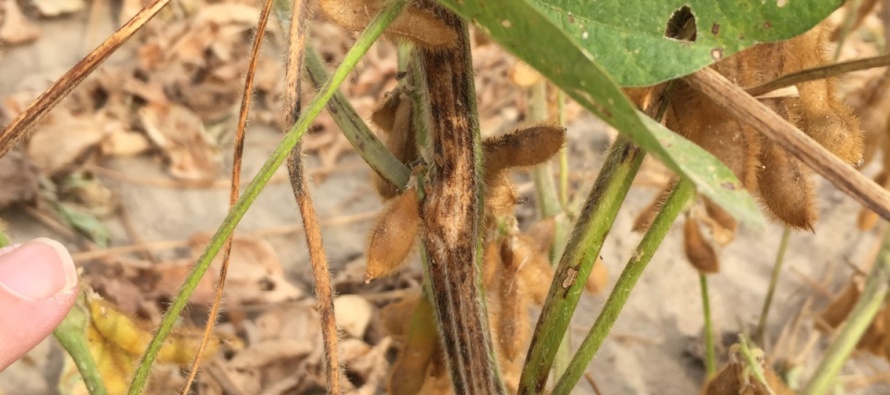Soybean Stem Canker: 2017 Visual Observations from the Clarksdale OVT

Related Articles
- 2010 Soybean And Corn Variety Trial Data 3
- Rice Variety Trial Results For 2010, Plus Rice Research Report 0
- Evaluation of Peanut Varieties in Mississippi, 2010 0
Latest Tweets
Several comments have been voiced about typographic errors or a harvest issue regarding the harvested yield from the Clarksdale official variety trial (OVT) (see: http://mafes.msstate.edu/variety-trials/includes/crops/soybeans.asp for preliminary yield data). Variety entries exhibiting extremely low yield, in some cases less than 10 bu/A, were observed to exhibit symptoms associated with stem canker. Visual observations of foliar disease were conducted as normal to assess the amount of Cercospora blight, frogeye leaf spot, Septoria brown spot, and target spot present. In addition, stem canker was visually observed for each of the maturity group (MG) blocks (MG IV early and late; MG V early and late) by considering the presence of foliar symptoms as well as the presence of a canker on the main stem. Ratings were conducted using a 0-9 scale whereby 0=no stem canker present in any of the plants within each of the plots and 9=severe stem canker that on the day of the observations had resulted in a lengthy canker on the main stem and severe interveinal chlorosis throughout the plot.
In addition to observing OVT locations for the presence of the diseases that occur naturally during the season, a toothpick-inoculated OVT set is planted in Stoneville specifically for the purposes of observing the response to the stem canker fungus. Toothpicks are infested with the fungus that causes stem canker and plants are inoculated by inserting the toothpick into the stem of the soybean plants at V5. Observations of the stem are made at approximately R6.5. Plants exhibiting lesions are then visually rated to determine the susceptibility to the stem canker fungus. In general, in the toothpick-inoculated stem canker screening program a ranking system has been used to present data as to the response of the variety. By using the Mean Disease Rating, a standardized designation system is as follows: 1 = Resistant, 3 = Moderately Resistant, 5 = Moderately Susceptible and 7 = Susceptible. The results from the stem canker toothpick inoculation trials should be available within a few weeks.
In most cases in the Clarksdale OVT, varieties exhibiting the lowest yield were observed to have greater stem canker rating values. However, be mindful that one MG V variety was included in the MG IV late set and therefore the stem canker observation would have been made 1-2 weeks early. Moreover, one variety in particular, Progeny P4255RX was observed to be susceptible to stem canker based on the presence of a severe lesion response (8.3=susceptible); however, the variety produced a yield of 79.9 bu/A. Be cautious when selecting a variety that may be susceptible to a disease such as stem canker since other factors may have played into yield production.
Maturity group IV early (Clarksdale OVT MG IV early)
Maturity group IV late (Clarksdale OVT MG IV late)
Maturity group V early (Clarksdale OVT MG V early)
Maturity group V late (Clarksdale OVT MG V late)
In addition to the stem canker at the Clarksdale OVT location (geographically north of Roundaway, MS), some commercial soybean fields containing stem canker-susceptible varieties were observed to be severely affected by the disease. The commercial fields were geographically less than 10 miles west from the OVT location and close to Duncan, MS. The two fields in question were planted to the same MG IV early variety that was reported to be susceptible to stem canker by the seed company. Reports obtained from consultants suggested that two fields contained the same variety and both fields harvested between 10 and 15 bu/A. The variety in question was not contained in the MSU OVT program for 2017 or any year prior to 2017. In addition, Arkansas has not looked at the variety in their program. My best advice for the 2018 season would be to not plant stem canker-susceptible varieties anywhere in the Mississippi soybean production system. In addition, do your homework on a variety prior to making a choice for your farm. Most varieties for sale in our production system should indicate the level of susceptibility (or resistance) to stem canker. If you have questions regarding the response of a specific variety, please call. Variety choice is the most important decision you will make each year.





This is a great eye-opener that shows the potential for yield reduction from stem canker. I would like to see a correlation graph.
Working on that situation over the next week.
Great information, Is there any group 3 data available?
Unfortunately not, the only year we looked at group IIIs was in 2016.